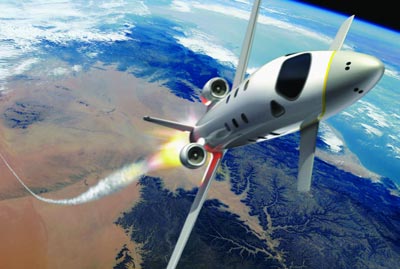European space tourism vehiclesby Taylor Dinerman
|
| Subsidies are wonderful things if someone else is paying the taxes that support them. |
EADS claims that they want to raise a billion euros of private capital to build their vehicle. This should raise a few eyebrows, since Rutan and his Scaled Composites team are building SpaceShipTwo for a lot less. That vehicle will, if it is built as planned, seat more passengers, weigh less, and be operational a lot sooner that the one proposed by the Europeans. SpaceShipTwo requires a separate aircraft, the White Knight, to carry it up to launch altitude, while the proposed European spaceplane takes off horizontally using its own jet engines—this is possibly significant.
The results of the Ansari X Prize frankly shocked a good part of the European aerospace establishment. Here was a group with no government support—though with some encouragement from NASA—going out on its own to build up an industry from nothing. With only prize money and a set of rules, Peter Diamandis and his supporters changed the nature of the aerospace game. Today one can speak of an American space tourism industry which may be small, but which does exist and which is attracting interest and investment.
The initial response was to belittle Rutan’s achievement, but now, however, they want to imitate him. EADS is a giant aerospace company: it has its own problems, but raising a billion euros in risk capital should not be one of them. But, why are they bothering to try and compete with the minnows in California and New Mexico?
European envy of America cannot be ruled out; Galileo and the A380 giant passenger aircraft exist at least partly due to this factor. However, there may be other reasons that, like Galileo, have a more direct military application. The EADS spaceplane may be the beginning of a step-by-step program aimed at developing a single stage to orbit (SSTO) launcher. More likely, given the configuration, it may be a technology development project for a future suborbital hypersonic bomber and strategic reconnaissance vehicle.
Since the French Mirage IV and the British Vulcan were retired, no European air force has any sort of bomber. So, if one believed the same logic that requires Europe to have its own satellite navigation system and its own strategic transport aircraft, why should they not want to have their own force of long-range bombers?
It is interesting to note that EADS executives cannot refrain from putting down the entrepreneurial Americans. “There are those who think you can design a rocket plane in a garage,” one official was quoted in Space News as saying. Yet the history of 20th century technology is filled with innovations that came out of garages, from the Wright Flyer to the personal computer.
| “There are those who think you can design a rocket plane in a garage,” one EADS official said. Yet the history of 20th century technology is filled with innovations that came out of garages, from the Wright Flyer to the personal computer. |
The EU’s industry commissioner, a German Social Democrat named Guenter Verhugen, came out against the project on the grounds that “its only for the super rich.” This reminds me of the time when the previous President Bush agreed to raise taxes on yachts, which ended up simply raising unemployment amongst boat builders in politically critical states such as Florida and Maine. Will the EU Commission be able to stop private individuals and firms from investing in the EADS venture? Theoretically, one supposes that that is impossible. Given the nature of the EU however, who knows? The subsidy gods may find it impossible to bless this project.
EADS plans to develop a LOX-methane engine for their vehicle, another indication that there is something odd about this project. NASA’s on-again, off-again, and now on-again effort to build such an engine for use on the Moon and eventually on Mars is intended to give the US a reliable way to get around the solar system using, at least in part, fuel made from off-Earth resources. Has EADS come to a similar conclusion?
In any case the US should welcome the competition in the space tourism sector. The Europeans may bring better food and more stylish space suits to the industry, and they certainly will insure that US or US/UK companies such as Branson’s Virgin Galactic don’t have the kind of monopoly on suborbital tourism that the Russian now have on the orbital kind.
